While there are many methods to cooking turkey, a roast spatchcock turkey allows for even cooking, juicy meat with perfectly crisp skin, and in only a fraction of the time!
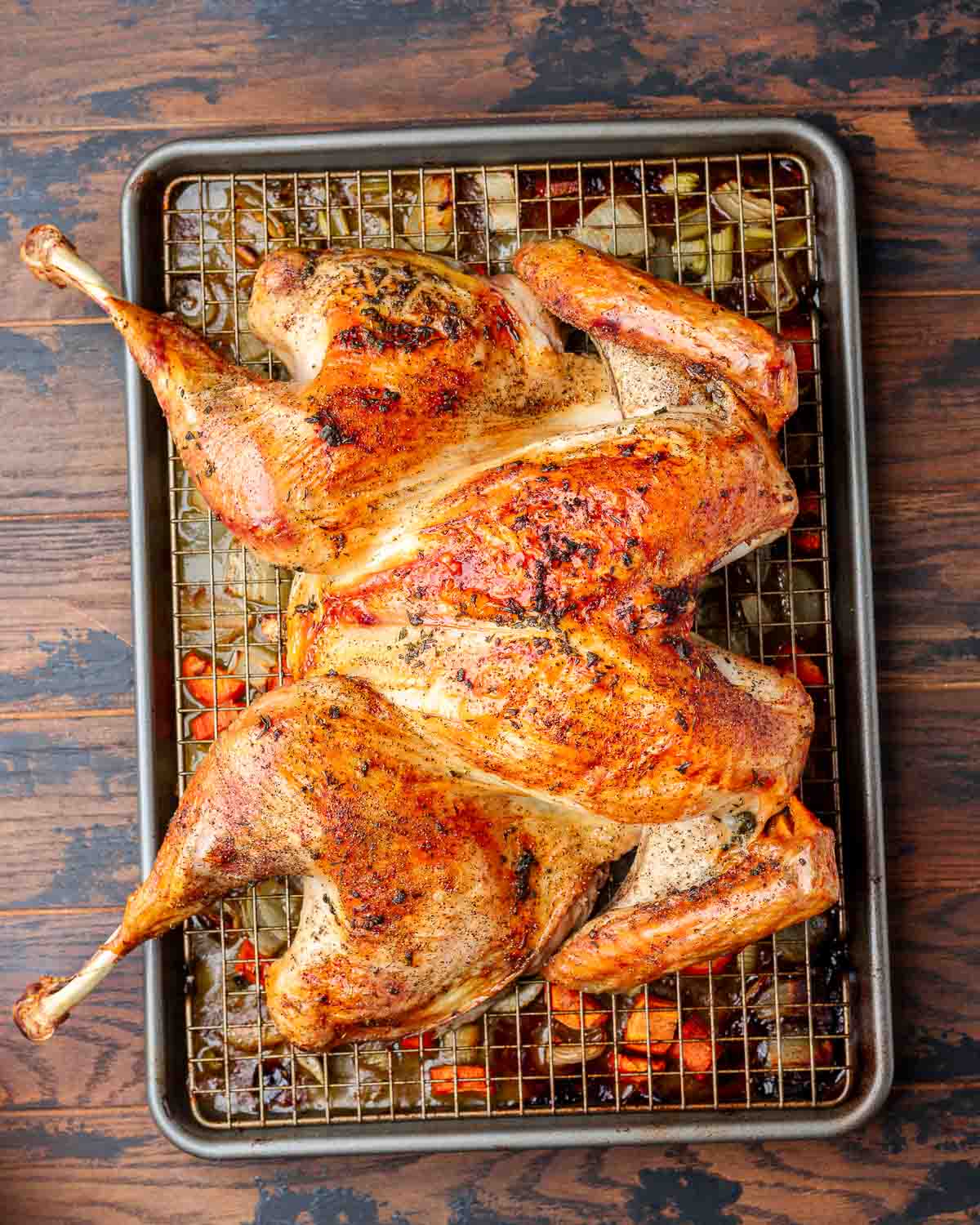
This post may contain affiliate links. Our disclosure policy.
It’s the holidays and you’re short on time and oven space!
Making a spatchcock turkey is one of those cheat codes that allows you to actually save time.
Spatchcocking a turkey, or any bird, means the backbone is removed which allows the turkey to be flattened; similar to butterflying.
A flattened turkey allows even cooking in way less time than a traditional roasted turkey freeing up oven space for other favorites like sweet potato casserole and garlic butter dinner rolls.
It also yields perfectly crisp skin and ultra-juicy meat!
And this spatchcock turkey recipe produces plenty of pan drippings so you can make the best giblet gravy.
Table of Contents
Recipe Ingredients
All ingredients for this recipe are shown in the pic below and special notes are made in this bulleted list to assist you.
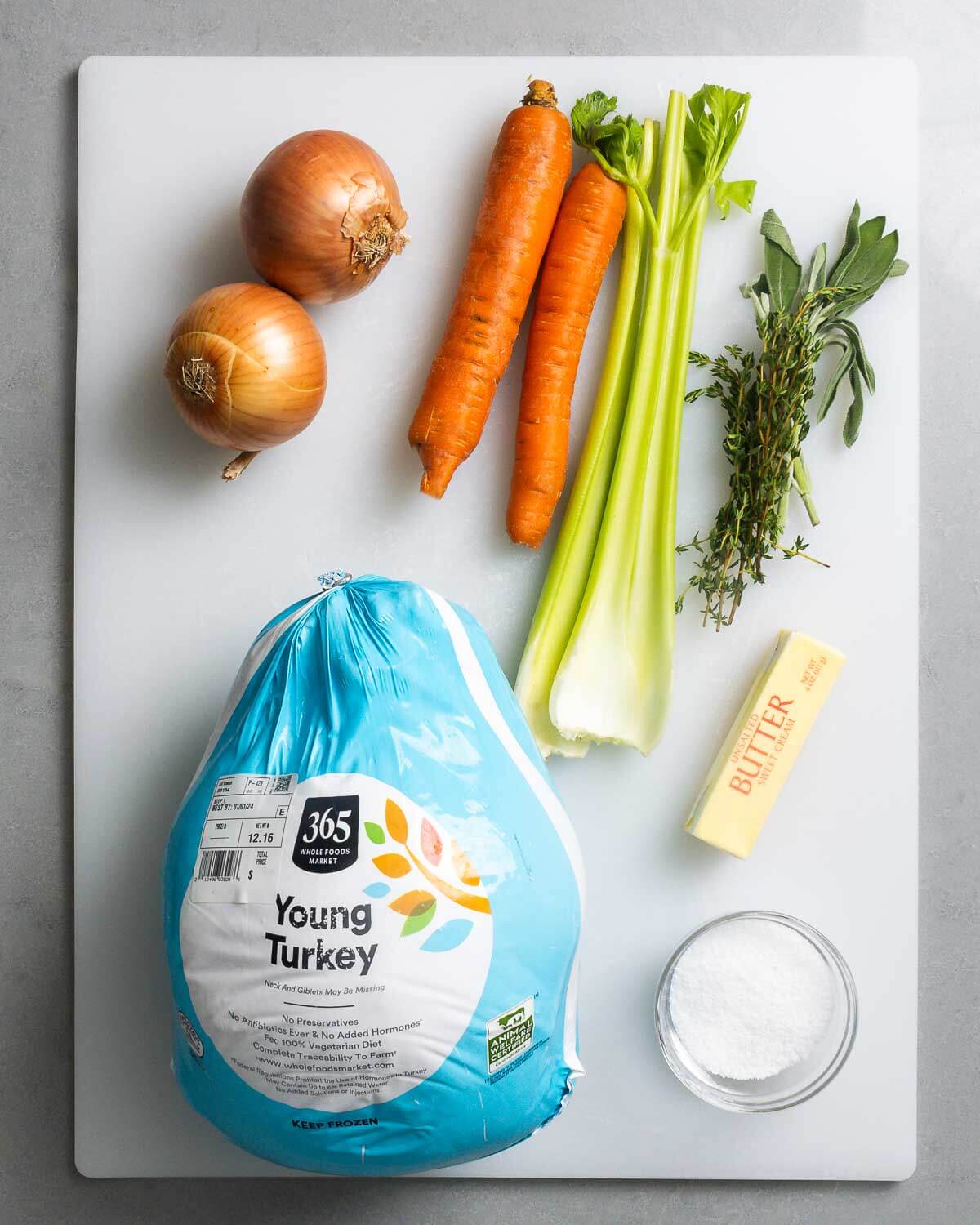
- Turkey. I recommend using a ~12-pound natural turkey with no added salt or preservatives. This will prevent you from oversalting while brining. If using a frozen turkey, you’ll need to allow yourself enough time for it to thaw. See below FAQ on thawing a turkey.
- Kosher salt (for the brine). Dry brining at a 1-1.25% salt ratio is recommended. Depending on the brand, you may need to use more or less tablespoons. For example, if using Diamond Kosher salt use 6 tablespoons; if using Morton’s kosher salt use 4 tablespoons for a 12-pound turkey.
- Carrots, celery, and onion. These are placed at the bottom of the pan and will catch the pan drippings and prevent them from burning. The drippings and veggies can be strained and used later to make a gravy if desired.
- Sage and thyme. Fresh thyme and fresh sage are used to make an herb butter that will be massaged into the turkey prior to roasting.
- Unsalted butter. For the herb butter.
See the recipe card for full information on ingredients and quantities.
How to make it
Each number corresponds to the numbered written steps below.
- Place a ~12-pound turkey on a large cutting board, breast side down, with the tail facing you. Pat it dry with paper towels. Locate the backbone and using a pair of kitchen shears, begin to cut starting at the tail end. Note: If making giblet gravy, be sure to save them and set aside. (Photo #1)
- Continue cutting all the way to the neck as shown. (Photo #2)
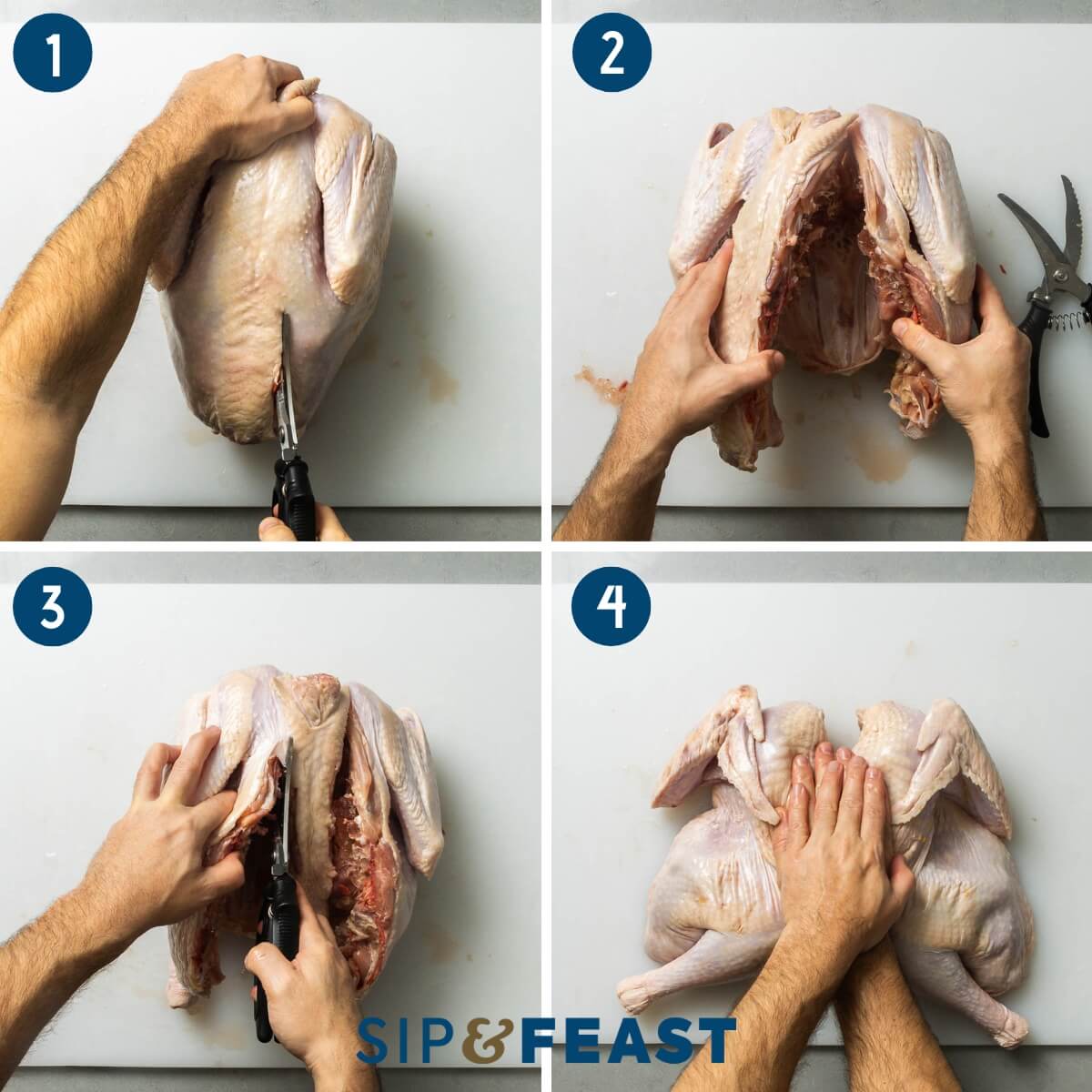
- Repeat the process on the other side of the backbone until the backbone is removed. Use the shears or a knife to cut away any loose overhanging skin by the neck opening. You can save the backbone for gravy or stock. (Photo #3)
- Flip the turkey over and use both hands to press the breast bone down until the turkey is splayed or flattened. You will likely hear a few cracks during this process. The goal here is to flatten the turkey for even cooking. (Photo #4)
- Place the turkey on a baking sheet and prepare to dry brine. If using Diamond Kosher salt, you’ll need 6 tablespoons; if using Morton Kosher salt you’ll need 4 tablespoons. Sprinkle the salt all over the turkey on both sides getting underneath parts of the skin, if possible. Don’t worry about using every bit of salt, just be sure to coat the turkey in all areas. Refrigerate overnight uncovered. (Photo #5)
- Remove the turkey from the fridge 1 hour before roasting. Remove 8 tablespoons of butter and allow it to soften to room temperature. Preheat the oven to 450 and set the rack to the middle level. Chop 2 large carrots, 3 ribs of celery, and 2 large onions and place them on a baking sheet, then place a wire rack on top. (Photo #6) Note: The vegetables help flavor the drippings and prevent burning. Alternatively, you can skip the vegetables and add 8-12 ounces of water to the pan which will also prevent burning of the drippings.
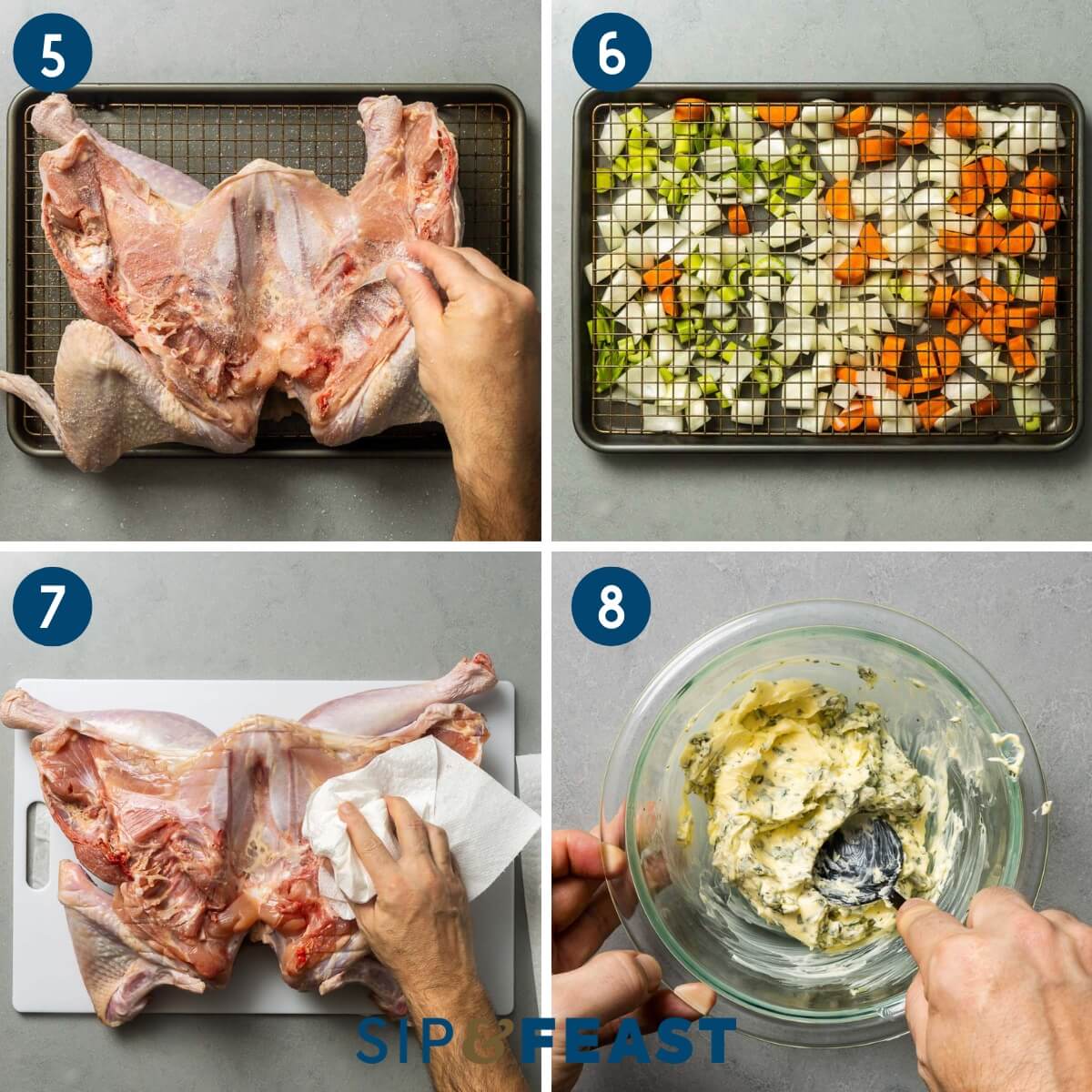
- Dry off the dry-bined spatchcocked turkey with paper towels and season with about 2 teaspoons of black pepper and place it on top of the wire rack above the vegetables. Tuck the wings under to prevent burning. (Photo #7)
- Mince 10 large sage leaves and remove 1 tablespoon worth of fresh thyme leaves and place in a bowl with the softened butter mixing until a paste is formed. (Photo #8)
- Spread the herb butter on top of the turkey and under the skin wherever possible, then place a probe thermometer into the thickest part of the breast and set the alarm to go off at 150f. (Photo #9)
- Roast the turkey in the oven rotating the pan 180 degrees at the halfway point. Note: It took me exactly 77 minutes in total with the 12-pound turkey, so the halfway point would have been ~40 minutes. Remove the turkey when the alarm goes off and the temperature reaches 150. Allow it to rest, lightly tented with foil, for about 30 minutes. As it rests, the temperature will continue to climb, resulting in it reaching ~165f. (Photo #10)
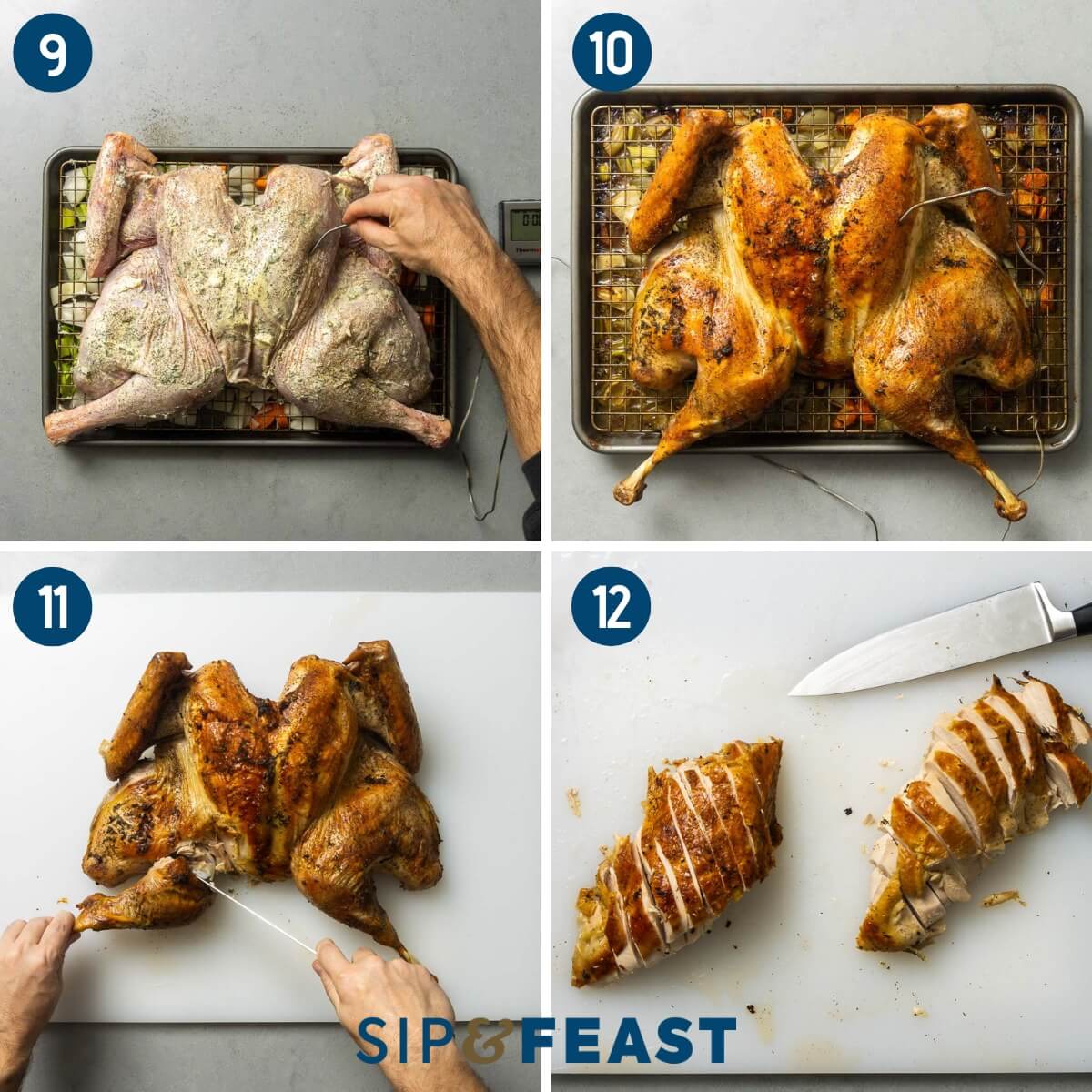
- After the turkey has rested and the temp has reached 165f, begin to carve the turkey by removing the legs and thighs first, then the breast and wings. If desired, place the dark meat (thighs and legs) back in the oven and cook until 185-190f while tenting the breast with foil to stay warm. This will allow the dark meat to become even more tender. (Photo #11)
- Slice the breast for easier serving. The vegetables, drippings, and backbone can be saved for making turkey gravy if desired. Place the carved turkey on a platter and serve with gravy and your favorite sides. (Photo #12) Enjoy!
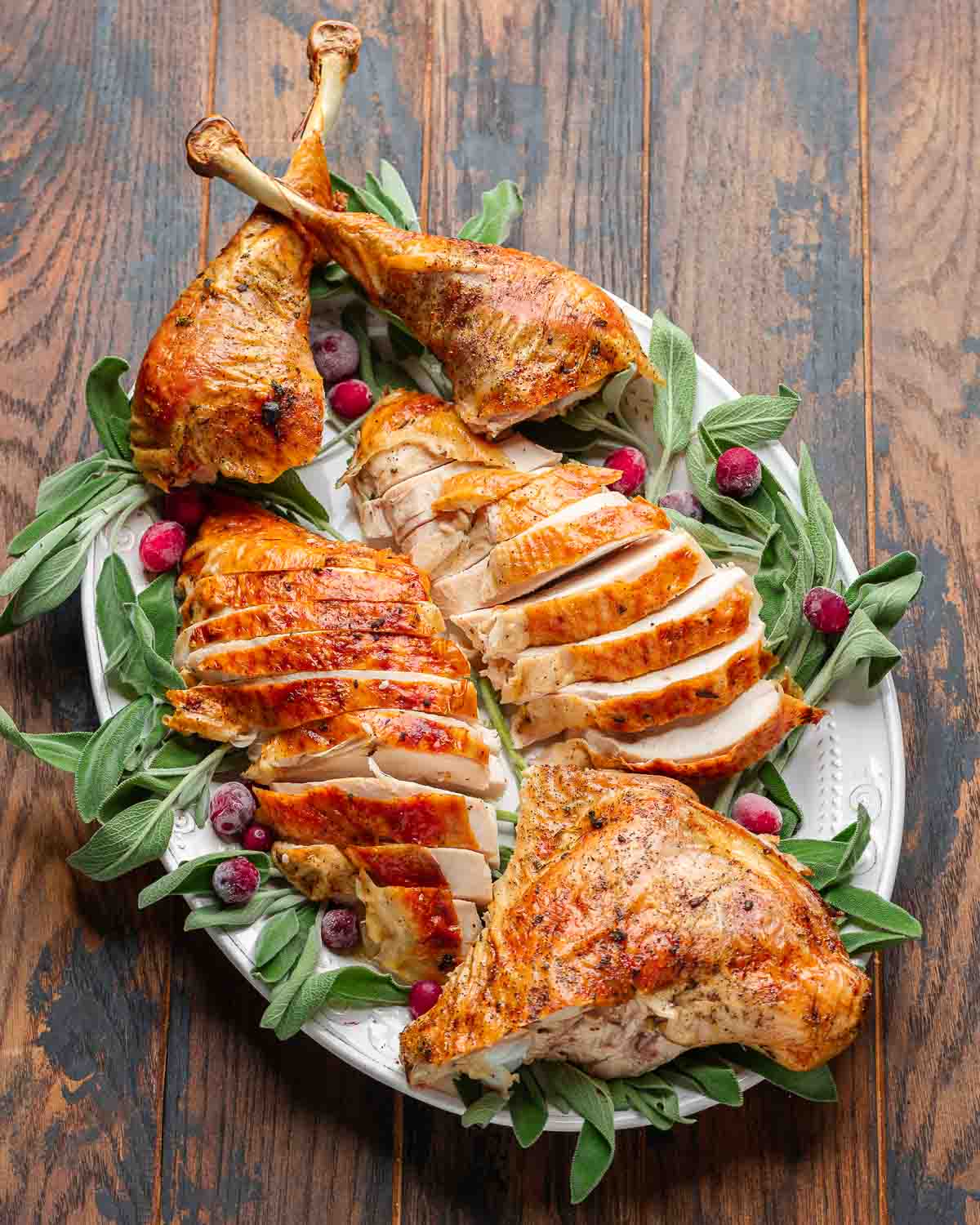
Want To Save This Recipe?
Top tips
- Dry brine the turkey. While you may be tempted to skip the brine, I assure you this process will yield a better, juicier turkey. It also helps get a browner, crispier skin. When shopping for a turkey look for one that’s natural with no salt added. Don’t brine a turkey that is sold in an already brined solution.
- Return the dark meat to the oven. While dark meat is safe to eat at 165, it is even better if cooked to 185-190f. This can be challenging since you don’t want to overcook the white meat. If desired, after resting and carving, tent the white meat with foil to stay warm, then return the legs and thighs to the oven and cook until they reach 185-190f. A spatchcocked turkey allows more even cooking and the dark meat might already be 185f during the initial roasting process. Make sure to check with an instant-read thermometer before placing any dark meat back in the oven. Note: If you and your guests are not fans of dark meat, you can always consider just doing a dry-brined turkey breast!
- Save the giblets, drippings, and vegetables. Together with a few more ingredients, these will make a fantastic giblet gravy!
Frequently Asked Questions
The USDA recommends thawing a frozen turkey in the refrigerator. The rule of thumb is 1 day for every 4-5 pounds, so for a 12-pound turkey it will take approximately 3 days to thaw. Once thawed, the turkey should be cooked within 2 days.
A good rule of thumb is to estimate between 1 – 1 1/2 pounds (this includes bone weight) per person. So if you have 10 guests, a 12-pound turkey should be perfect.
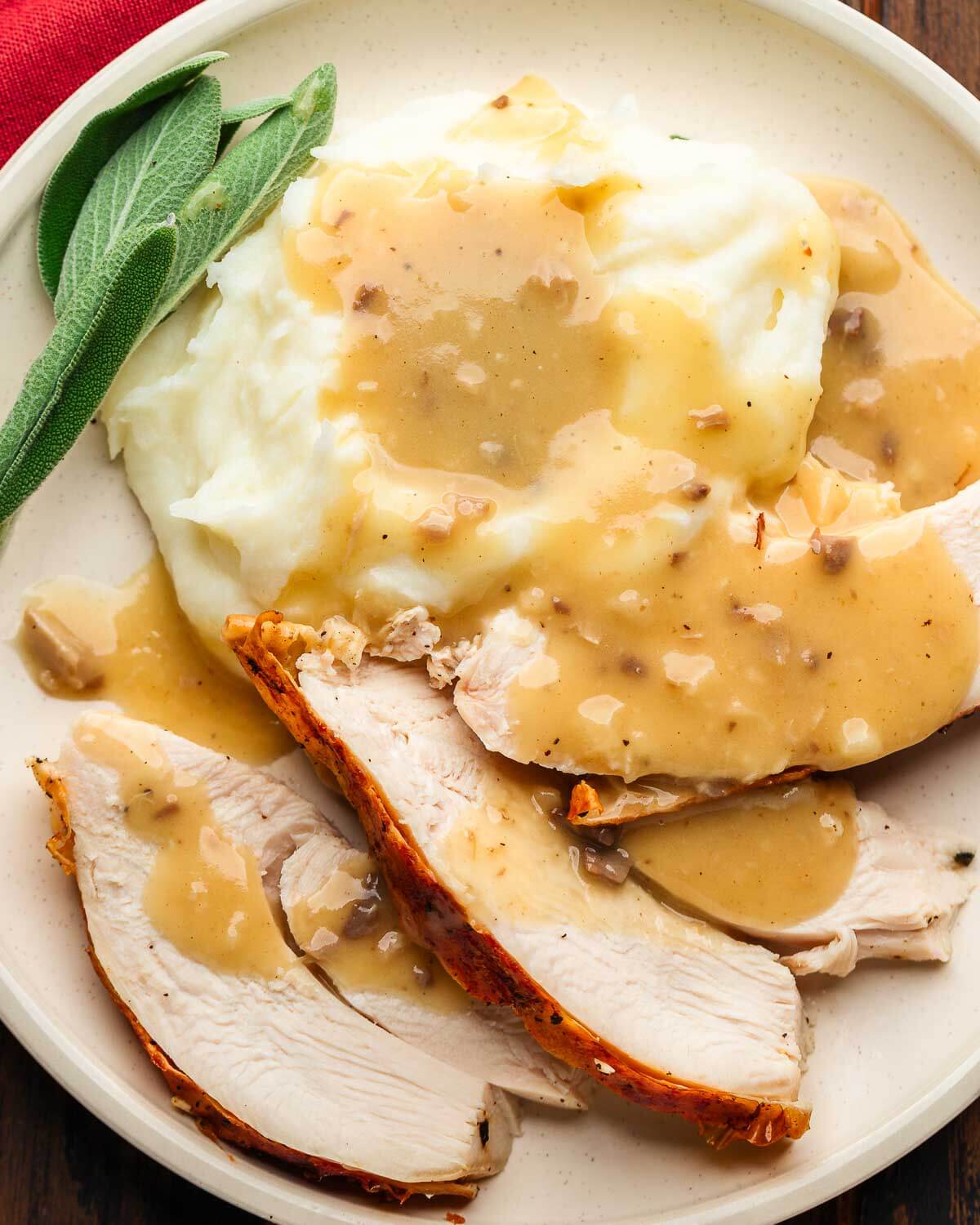
More Thanksgiving favorites
- Roasted Brussels Sprouts and Carrots – the easiest side ever!
- Italian Sausage Stuffing – with Parmigiano Reggiano.
- Mashed Potatoes – with roasted garlic.
- Thanksgiving Sangria – with apples and pears.
- Pumpkin Pie – with an amaretti cookie crust and amaretto whipped cream.
- Apple Crostata – this rustic tart is easier than pie!
If you’ve enjoyed this Spatchcock Turkey recipe or any recipe on this site, give it a 5-star rating and tell us about it in the comments below.
We strive to satisfy a number of learning styles. If you are someone who prefers to learn by watching, you can find most of our recipes on YouTube and our Facebook Page.
Spatchcock Turkey
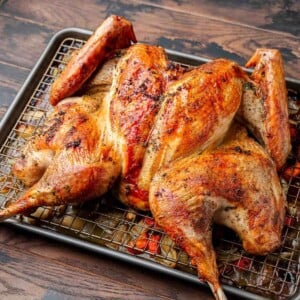
Ingredients
For the brine
- 1 12 pound natural or organic turkey (no salt added) see notes below
- 6 tablespoons Diamond Crystal Kosher salt or 4 tablespoons Morton's kosher salt
Remaining ingredients
- 2 large carrots chopped
- 3 ribs celery chopped
- 2 large onions chopped
- 2 teaspoons black pepper
For the herb butter
- 1 tablespoon thyme leaves
- 10 large sage leaves minced
- 8 tablespoons unsalted butter softened
Want To Save This Recipe?
Instructions
Brining the turkey
- Place the turkey on a large cutting board, breast side down and with the tail side facing you. Pat it dry with paper towels.
- Using kitchen shears, begin cutting from the tail end on one side of the backbone all the way to the neck. Repeat the same cut on the other side of the backbone. You can cut away any loose overhanging skin by the neck opening. Save the backbone for gravy or stock.
- Flip the turkey over and with two hands press the breast bone down until the turkey is splayed or flattened. You should hear a couple of cracks during this process. The goal is to flatten the turkey for even cooking.
- Place the turkey on a baking sheet and sprinkle the salt all over the bird on both sides and underneath parts of the skin if possible. Don't worry about using every bit of the salt, just make sure to cover the bird in all areas. Refrigerate overnight uncovered.
Roasting the turkey
- Remove the turkey 1 hour before roasting. Preheat the oven to 450f and set the rack to the middle level.
- Mix the butter with the thyme and sage to form a paste.
- Place all of the vegetables on a baking sheet and then place a wire rack on top of them.
- Dry off the turkey with paper towels and season with pepper. Place the turkey on top of the baking sheet/wire rack and tuck the wings underneath to prevent burning. Spread the herb butter on top and underneath the skin.
- Place a probe into the thickest part of the breast and set the alarm to go off at 150f. Roast turkey, rotating the pan 180 degrees at halfway point.
- Once the alarm goes off, remove it from the oven and let rest for 30 minutes before carving. See notes below for more info on optimally cooking dark meat.
- The vegetables, drippings, and backbone can be saved for making turkey gravy if desired. Enjoy!
Notes
- Cook the turkey until the breast reaches 150f and let rest until it reaches 165f. Dark meat is best cooked to 185-190f but that is hard to achieve without overcooking the white meat. If desired, after carving, place the dark meat back into the oven and cook until 185f while tenting the white meat with foil to keep warm.
- Only dry brine the turkey if it is a natural no-salt-added turkey. Many turkeys are sold in a brined solution so pay attention to not oversalt the turkey.
- Brine at a 1-1.25% ratio of salt to turkey weight for a delicious but not overly salty bird. A 12-pound turkey weighs 5448 grams so it needs 54-68 grams of salt which equals roughly 2 3/4-3 1/2 tablespoons of table salt. When using kosher salt you will need to use more tablespoons because a tablespoon of kosher salt weighs less than a tablespoon of table salt. See table below:
- 1 Tablespoon of Table salt = ~19 grams
- 1 Tablespoon Morton kosher salt = ~15 grams
- 1 Tablespoon Diamond Crystal kosher salt = ~10 grams
- Leftovers can be saved for up to 3 days in the fridge.
- For larger turkeys that may overhang a standard baking sheet, line the bottom rack of the oven with foil to catch any butter and drippings and help prevent smoking.
Nutrition
Nutrition information is automatically calculated, so should only be used as an approximation.
Follow Me







Turned out great!
So happy you enjoyed, MJ!
I made this for New Year’s Day, it turned out delicious but like one other comment I needed to turn down the oven from 450. And the rack was a bit below middle. If I did not, the bird would have been charred.
We found 450 degrees almost burnt the skin and the vegetables at the bottom of the pan.
Hi Martha, sorry to hear you found the heat was too high. The oven rack should be set to the middle level – if you had it on the lower level it could have played a role in burning the vegetables.
Great recipe! Found while looking for overnight dry brine. Didn’t realize at least 36 hours needed. Thankfully with this recipe, overnight worked out! Added brown sugar, herbs, onion and garlic powder to dry brine mix. Poured apple cider vinegar and scratch made turkey/mushroom stock to veggies to stream while on higher heat. Best turkey ever with less effort! Thank you for sharing!